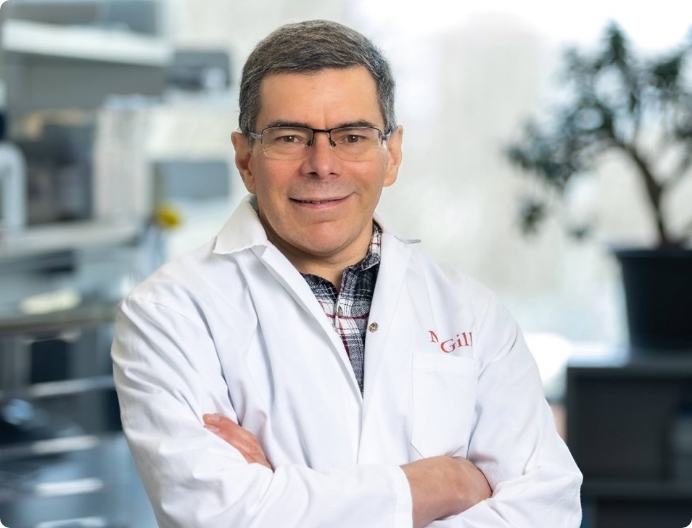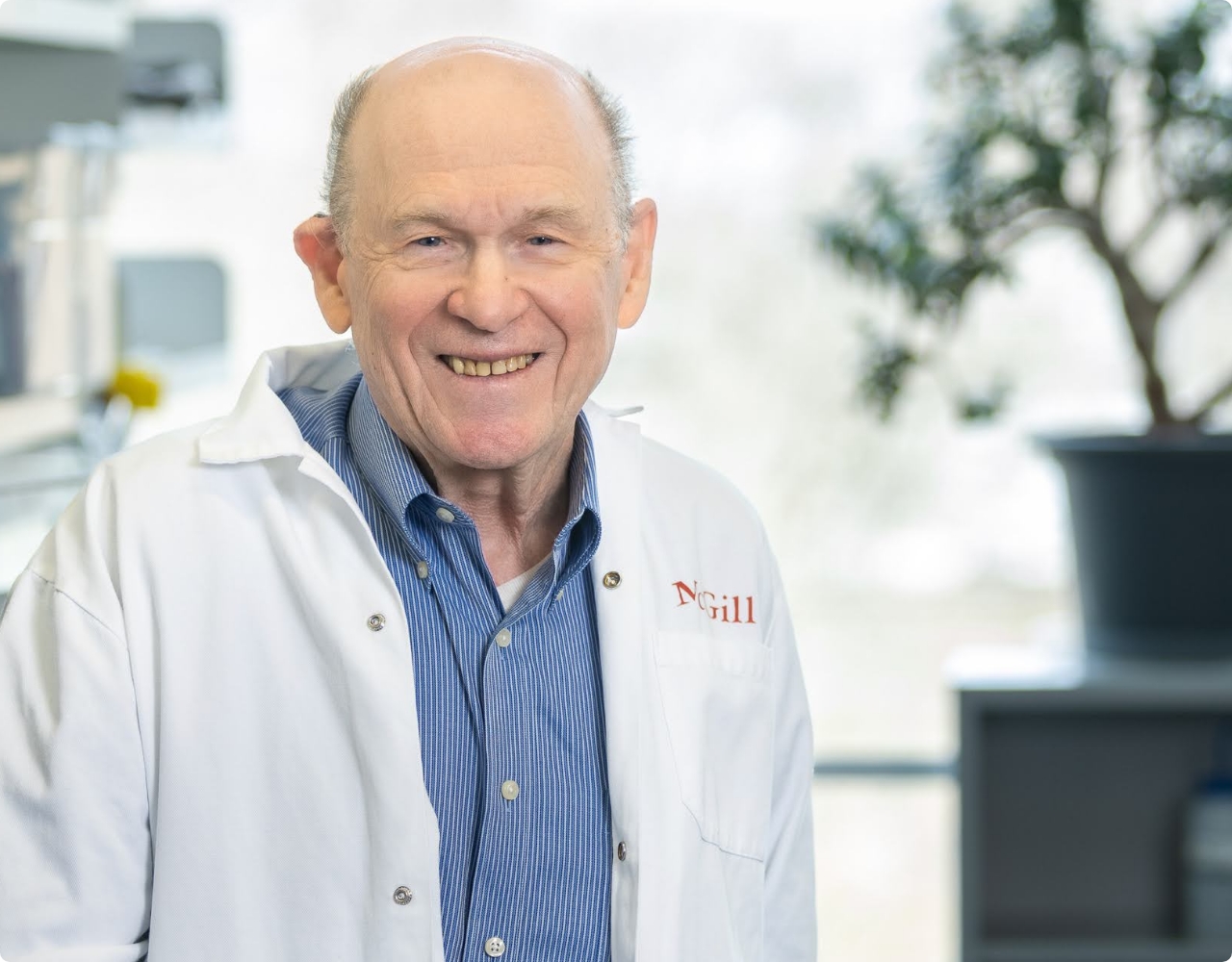
About Dr. Sonenberg’s high impact research
mRNA vaccines are a breakthrough in science innovation demonstrating the speed and flexibility to respond to a global pandemic. A huge support for this scientific advance was the years and decades of basic fundamental science research applied to our understanding of mRNA, how it is made (transcribed) and how in turn it is read and made into proteins (translated). Dr. Nahum Sonenberg contributions to research in cancer biology with his approach to mRNA were incorporated into this complex effort.
An outcome of the recent global pandemic has been the introduction to the world of a new form of vaccines composed of “messenger RNA” or mRNA. mRNA functions as an intermediary, allowing the genetic information encoded by DNA to be read and translated into proteins. Proteins play a vital role in the functions of our biology as they give structure to our cells and tissues, perform a multitude of chemical reactions and signals within the body including the production of antibodies and other immune molecules. The goal of a vaccine is to have the body generate a protective immune response involving, initially, the production of antibodies and eventually, the generation of memory immune cells that can be called back into action at a later date when the body is exposed to the virus. Most vaccines to date have been composed of either killed or inactivated virus or in some cases, viral proteins cultured in the laboratory.
Utilizing mRNA to be the component in a vaccine relies on the ability of the cells in the body to take in mRNA and make protein, or in other words, our cells become the “factories” to produce the proteins needed to stimulate the immune response. This method is potentially safer as no virus or viral protein is directly injected into the body and mRNA is rapidly cleared from our system, usually last hours or days. Furthermore, mRNA vaccines allow exposure solely to one specific part of the virus protein and nothing else. It offers flexibility, as by changing the sequences of the mRNA it is possible to generate a new vaccine against a new virus or variant. The pharmaceutical company Moderna was able to, in a record-breaking 42 days, take the genetic sequence for SARS-Cov2 that was shared by Chinese researchers on the internet, select the sequence for the spike protein, and prepare an mRNA vaccine candidate ready for testing in humans (reference Boston Magazine article). The speed and flexibility of the SARS-Cov2 mRNA vaccine development were only possible because of the decades of groundwork by scientists researching and understanding the mechanics of how mRNA is translated into protein and how this process is regulated.
2012, a new collaboration with Moderna
In 2012, Moderna approached Nahum Sonenberg, a professor and researcher at the Goodman Cancer Institute of McGill University, to consult as he is an expert in RNA biology and studies the mechanics of mRNA translation. Sonenberg along with Yuri Svitkine reported in 2017 in Nucleic Acids Research that modification of one of the nucleic acids of mRNA, uridine, to N1-methylpseudouridine would still allow the molecule to be read for translation, yet was sufficiently different from uridine to avoid activating the immune system which was a serious problem previously described by Katalin Karikó (Immunity 2005} and furthermore, this modification would lead to better translation of the mRNA. Moderna uses this chemical modification in its SARS-Cov2 vaccine.
A legacy 50 years in the making
Nahum Sonenberg has dedicated over 50 years to studying RNA biology, focusing on RNA translation, understanding how the mechanisms function normally and how they go awry and whether these changes can cause disease. His RNA journey began in 1975 when he reported in a PNAS article that RNA, specifically 23S ribosomal RNA was crucial in the process of translating mRNA into proteins by associating with peptidyl transferase, the enzyme that catalyzes the reaction to bond amino acids together. In 1976, joined the lab of Aaron Shatkin, who along with Yushiro Furuichi, had previously identified a cap-like structure on one end of mRNA that was necessary for protein synthesis in eukaryotes. Shatkin thought that as Sonenberg had performed affinity-labeling techniques during his PhD that he would be perfectly suited to discover and identify proteins that bind to the cap structure of mRNA. Others had previously identified proteins that they thought bound to the mRNA cap but those reports later turned to be incorrect. The ones who correctly identified cap-binding protein were Sonenberg and colleagues in 1978 where they also demonstrated that this binding step is crucial to kick-start the process of protein synthesis. This cap-binding protein, named eukaryotic initiation factor subunit (eIF4E) was to become part of Sonenberg’s lifetime of study.

Jerry Pelletier, Ph.D.
Joining McGill in 1979
Sonenberg joined McGill in 1979 and continued studying RNA translation. Together, he and Jerry Pelletier demonstrated how poliovirus RNA, which lacks the cap structure, is uniquely translated. Sonenberg’s research lab was on the 8th floor of the McIntyre Medical Research Building at McGill and he interacted closely with colleagues in the McGill Cancer Center on the floor below. In 1990 Sonenberg reported in Nature that eIF4E, which is typically present in the cell in limited amounts, when overexpressed whether in cells in culture or in mice would lead to increased cell proliferation and tumor formation, respectively. It was decades later, when working in with mice that were modified to have a form of eIF4E that could not be phosphorylated that they observed these mice to be resistant to the formation of prostate cancer tumors. When they looked at normal mice they saw increased phosphorylation of eIF4E would lead to a subsequent increase in synthesis of proteins involved in tumor formation. When they looked in humans they saw that increased phosphorylation of eIF4E correlated with disease progression in prostate cancer patients. Together these results suggest drugs that inhibit phosphorylation of eIF4E could act as anticancer therapies.
Sonenberg identified another family of proteins, that when bound to eIF4E, would turn off the protein synthesis, or in other words, could act as brakes to stop protein synthesis. In 1994 he showed that these eIF4E binding proteins, termed 4E-BPs, are themselves regulated by different factors, including in insulin. Insulin led one of the 4E-BPs to be hyperphosphorylated, making it no longer able to bind to eIF4E, thus releasing the brake, and enabling protein synthesis to proceed. A signaling complex, mTORC1, also phosphorylates 4E-BPs and is shown to be hyperactive in various cancers. In 2010, using mice not expressing 4E-BP, Sonenberg showed that mTORC1 mediates cell proliferation controlled by 4E-BPs, which may lead to the development of cancer.

Mauro Costa-Mattioli, Ph.D.
Discovering the role of mRNA translation control
While performing studies with 4E-BP1 and 4E-BP2 knockout mice, a collaborator mentioned that it is essential to have new protein synthesis for memories to form. The question arose as how these knockout animals would fare in memory and learning studies. Mauro Costa-Mattioli who was working as a post-doctoral fellow with Sonenberg was eager to work on memory and learning despite Sonenberg trying to dissuade him, as teaching mice to learn the mazes and measuring memory is difficult. Nevertheless, Costa-Mattioli prevailed and opted to study mice that had a protein kinase, GCN2, knocked out. Using these and numerous other types of knock-out mice, they identified the role mRNA translation control can have in generating memory and how dysregulation of this control can play a factor in neurological diseases and conditions, including autism.

Thomas Duchaine, Ph.D.
Game-changing knowledge
Control of mRNA translation has been of great interest among biologists and in 1993 short RNA chains, or microRNA (miRNA) were described and suggested to regulate translation through an antisense RNA-RNA interaction. miRNAs were then used widely in laboratories to reduce gene expression however the mechanism by which they worked was unclear. A debate raged with sides arguing miRNA function by targeting mRNA for rapid degradation by the cellular machinery while others argued that miRNA directly inhibit RNA translation. In 2007 Sonenberg and Thomas Duchaine, using an in vitro model of a cell-free translation, demonstrated that rapidly, within 15 minutes, there was a blockage of RNA translation, which was far too soon for RNA to be degraded. A decade later, they showed that a different mRNA cap-binding protein, 4EHP, contributed to miRNA to stop translation.
Most recently, Sonenberg published that the diabetes medication, metformin, alleviated the symptoms of fragile-X syndrome in a mouse model of the disease and is hopeful that if efficacy is shown in clinical studies, this may rapidly be rolled out as a treatment for the disease in humans, as the drug safety profile of metformin is well established.

Photo Credits: Owen Egan
More to come
Sonenberg’s pursuit in understanding the mechanics of RNA translation and how it is regulated both in normal conditions and in disease states has improved our understanding of various diseases including cancer, diabetes, autism, and fragile X syndrome. Fundamental research of the basic biology is important and critical and provides the foundation for applied research. It is crucial for the public and funding agencies to appreciate the importance and need of basic science research. When new scientific methods or techniques are reported, as in the case of DNA sequencing, PCR or generation of knockout mice, the impact is often immediate. In contrast, basic science advances tend to only be appreciated over the long term (decades, many decades). Only by understanding what happens in the human body can we use then use this knowledge to help us treat diseases. The reality is that we fully know so little of what happens within our bodies and there are many unanswered questions awaiting discoveries. His advice to all students is “Do not despair, science is hard but discoveries are what is exciting about science”.
Dr. Nahum Sonenberg
legacy timeline
1946
Born in Germany in a displaced persons camp (post WWII).
1948
Family emigrated to Jaff, moved to Tel Aviv in 1956.
1968
Earned an undergraduate degree in microbiology at Tel Aviv University.
1972
Received M.Sc. in microbiology at Tel Aviv University. Enrolls in doctoral program at Weizmann Institute in laboratory of Ada Zamir.
1975
Report of 23S ribosomal RNA involvement in the enzyme peptidyl transferase which acts to link amino acids together.
1978
Identification of protein, eIF4e, that binds to the mRNA cap structure in PNAS adn kickstarts the translation process.
1988
Identification of how polio virus, that does not have a cap structure on its mRNA, is able to commandeer the human cell machinery to produce mRNA.
1990
Overexpression of cap binding protein eIF4e leads to increased proliferation of cells and tumor formation in mice.
1994
Demonstrates presence of proteins that bind eIF4e (4E-BPs) to run off protein translation and can be regulated by insulin.
2005
mTOR complex 1 mediated cell growth proliferation but not cell growth is controlled by 4E-BPs(v).
2007
eIF2alpha phosphorylation bidirectionally regulates the switch from short term to long term synaptic plasticity and memory. MicroRNA inhibition of translation initiation in vitro.
2010
Increased phosphorylation of eIF4e is associated with disease progression in patients with cancer progression. Demonstration of kinases in memory and synaptic plasticity in GCN2 knockout mice.
2013
Report on eIF4e dysregulation in autism. Report of circadian rhythm control by mTOR/4E-BP signalling.
2017
Demonstration that metformin improves the symptoms of fragile-X syndrome in mouse model. Demonstration of nucleotide analog later used in Moderna mRNA vaccine against COVID-19.
References
Discovery of a Cancer Biomarker by Researchers of the Rosalind & Morris Goodman Cancer Institute



